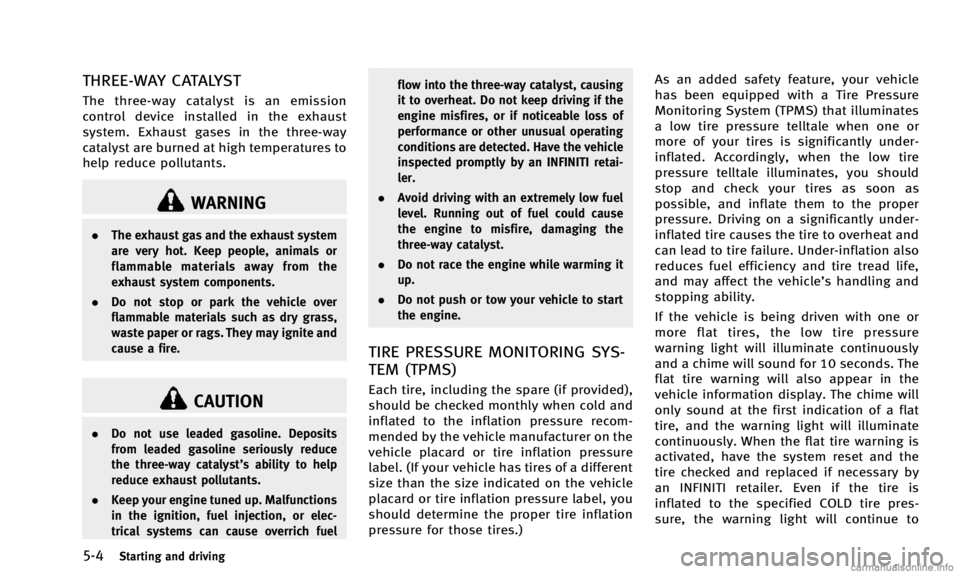display INFINITI Q50 2014 Owner's Guide
[x] Cancel search | Manufacturer: INFINITI, Model Year: 2014, Model line: Q50, Model: INFINITI Q50 2014Pages: 394, PDF Size: 1.99 MB
Page 170 of 394

Selecting the memorized position
1. Move the shift lever to the P (Park)position.
2. Push the memory switch (1 or 2) fully for at least 1 second.
The driver’s seat, steering column and
outside mirrors will move to the mem-
orized position with the indicator light
flashing, and then the light will stay on
for approximately 5 seconds.
Linking log-in function to a stored
memory position
The log-in function can be linked to a
stored memory position with the following
procedure.
1. Place the ignition switch in the ONposition while carrying an Intelligent
Key that was registered to the vehicle
with the log-in function. For more
details, see “Log-in function” (P.3-14).
2. Adjust the position of the driver’s seat, steering column and outside mirrors
manually. See “Seats”(P.1-2),“Tilt/
telescopic steering” (P.3-24) and“Out-
side mirrors” (P.3-27).
3. Place the ignition switch in the OFF position. The next time you log in (selecting the user
on the display) after placing the ignition
switch in the ON position while carrying
the Intelligent Key, the system will auto-
matically adjust to the memorized driving
position.
SYSTEM OPERATION
The automatic drive positioner system will
not work or will stop operating under the
following conditions:
.
When the vehicle is moving.
. When the adjusting switch for the
driver’s seat and steering column is
turned on while the automatic drive
positioner is operating.
. When the memory switch 1 or 2 is
pushed for less than 1 second.
. When the seat, steering column and
outside mirrors have already been
moved to the memorized position.
. When no position is stored in the
memory switch.
. When the shift lever is moved from the
P (Park) position to any other position.
(However, it will not be canceled if the
switch is pushed while the seat and
steering column are returning to the
previous positions (entry/exit func- tion).)
Pre-driving checks and adjustments3-31
Page 179 of 394

5-4Starting and driving
THREE-WAY CATALYST
The three-way catalyst is an emission
control device installed in the exhaust
system. Exhaust gases in the three-way
catalyst are burned at high temperatures to
help reduce pollutants.
WARNING
.The exhaust gas and the exhaust system
are very hot. Keep people, animals or
flammable materials away from the
exhaust system components.
. Do not stop or park the vehicle over
flammable materials such as dry grass,
waste paper or rags. They may ignite and
cause a fire.
CAUTION
.Do not use leaded gasoline. Deposits
from leaded gasoline seriously reduce
the three-way catalyst’s ability to help
reduce exhaust pollutants.
. Keep your engine tuned up. Malfunctions
in the ignition, fuel injection, or elec-
trical systems can cause overrich fuel flow into the three-way catalyst, causing
it to overheat. Do not keep driving if the
engine misfires, or if noticeable loss of
performance or other unusual operating
conditions are detected. Have the vehicle
inspected promptly by an INFINITI retai-
ler.
. Avoid driving with an extremely low fuel
level. Running out of fuel could cause
the engine to misfire, damaging the
three-way catalyst.
. Do not race the engine while warming it
up.
. Do not push or tow your vehicle to start
the engine.
TIRE PRESSURE MONITORING SYS-
TEM (TPMS)
Each tire, including the spare (if provided),
should be checked monthly when cold and
inflated to the inflation pressure recom-
mended by the vehicle manufacturer on the
vehicle placard or tire inflation pressure
label. (If your vehicle has tires of a different
size than the size indicated on the vehicle
placard or tire inflation pressure label, you
should determine the proper tire inflation
pressure for those tires.) As an added safety feature, your vehicle
has been equipped with a Tire Pressure
Monitoring System (TPMS) that illuminates
a low tire pressure telltale when one or
more of your tires is significantly under-
inflated. Accordingly, when the low tire
pressure telltale illuminates, you should
stop and check your tires as soon as
possible, and inflate them to the proper
pressure. Driving on a significantly under-
inflated tire causes the tire to overheat and
can lead to tire failure. Under-inflation also
reduces fuel efficiency and tire tread life,
and may affect the vehicle’s handling and
stopping ability.
If the vehicle is being driven with one or
more flat tires, the low tire pressure
warning light will illuminate continuously
and a chime will sound for 10 seconds. The
flat tire warning will also appear in the
vehicle information display. The chime will
only sound at the first indication of a flat
tire, and the warning light will illuminate
continuously. When the flat tire warning is
activated, have the system reset and the
tire checked and replaced if necessary by
an INFINITI retailer. Even if the tire is
inflated to the specified COLD tire pres-
sure, the warning light will continue to
Page 180 of 394

illuminate until the system is reset by an
INFINITI retailer. Your vehicle can be driven
for a limited time on a flat tire. See“Run-
flat tires” (P.8-36).
Please note that the TPMS is not a
substitute for proper tire maintenance,
and it is the driver’ s responsibility to
maintain correct tire pressure, even if
under-inflation has not reached the level
to trigger illumination of the TPMS low tire
pressure telltale.
Your vehicle has also been equipped with a
TPMS malfunction indicator to indicate
when the system is not operating properly.
The TPMS malfunction indicator is com-
bined with the low tire pressure telltale.
When the system detects a malfunction,
the telltale will flash for approximately one
minute and then remain continuously
illuminated. This sequence will continue
upon subsequent vehicle start-ups as long
as the malfunction exists. When the mal-
function indicator is illuminated, the sys-
tem may not be able to detect or signal low
tire pressure as intended. TPMS malfunc-
tions may occur for a variety of reasons,
including the installation of replacement or
alternate tires or wheels on the vehicle that
prevent the TPMS from functioning prop- erly. Always check the TPMS malfunction
telltale after replacing one or more tires or
wheels on your vehicle to ensure that the
replacement or alternate tires and wheels
allow the TPMS to continue to function
properly.
Additional information
.
The TPMS does not monitor the tire
pressure of the spare tire (if so
equipped).
. The TPMS will activate only when the
vehicle is driven at speeds above 16
MPH (25 km/h). Also, this system may
not detect a sudden drop in tire
pressure (for example a flat tire while
driving).
. The low tire pressure warning light does
not automatically turn off when the tire
pressure is adjusted. After the tire is
inflated to the recommended pressure,
the vehicle must be driven at speeds
above 16 MPH (25 km/h) to activate the
TPMS and turn off the low tire pressure
warning light. Use a tire pressure gauge
to check the tire pressure.
. The “Tire Pressure Low - Add Air”
warning appears in the vehicle informa-
tion display when the low tire pressure warning light is illuminated and low tire
pressure is detected. The
“Tire Pressure
Low - Add Air” warning turns off when
the low tire pressure warning light
turns off.
The “Tire Pressure Low - Add Air”
warning does not appear if the low tire
pressure warning light illuminates to
indicate a TPMS malfunction.
. The “Flat Tire - Visit dealer” warning
appears in the vehicle information dis-
play when the low tire pressure warn-
ing light is illuminated and one or more
flat tires are detected.
. Tire pressure rises and falls depending
on the heat caused by the vehicle’s
operation and the outside temperature.
Low outside temperature can lower the
temperature of the air inside the tire
which can cause a lower tire inflation
pressure. This may cause the low tire
pressure warning light to illuminate. If
the warning light illuminates in low
ambient temperature, check the tire
pressure for all four tires.
. You can also check the pressure of all
tires (except the spare tire) in the
vehicle information display. (See “Ve-
hicle information display” (P.2-20).)
Starting and driving5-5
Page 187 of 394

5-12Starting and driving
If the battery of the vehicle is discharged,
the push-button ignition switch cannot be
turned from the LOCK position.
Some indicators and warnings for opera-
tion are displayed in the vehicle informa-
tion display between the speedometer and
tachometer. (See“Vehicle information dis-
play” (P.2-20).)
The ignition lock is designed so that the
ignition switch position cannot be switched
to LOCK until the shift lever is moved to the
P (Park) position.
When the ignition switch cannot be pushed
toward the LOCK position, proceed as
follows:
1. Move the shift lever into the P (Park) position.
2. Push the ignition switch to the OFF position. The ignition switch position
indicator will not illuminate.
3. Open the door. The ignition switch will change to the LOCK position.
The shift lever can be moved from the P
(Park) position if the ignition switch is in
the ON position and the brake pedal is
depressed.PUSH-BUTTON IGNITION SWITCH
POSITIONS
LOCK (Normal parking position)
The ignition switch can only be locked in
this position.
The ignition switch will be unlocked when
it is pushed to the ACC position while
carrying the Intelligent Key.
ACC (Accessories)
This position activates electrical acces-
sories such as the radio, when the engine
is not running.
ON (Normal operating position)
This position turns on the ignition system
and electrical accessories.
OFF
The engine can be turned off in this
position.
The ignition lock is designed so that the
ignition switch cannot be switched to the
LOCK position until the shift lever is moved
to the P (Park) position.
CAUTION
Do not leave the vehicle with the push-
button ignition switch in ACC or ON posi-
tions when the engine is not running for an
extended period. This can discharge the
battery.
EMERGENCY ENGINE SHUT OFF
To shut off the engine in an emergency
situation while driving, perform the follow-
ing procedure:
. Rapidly push the push-button ignition
switch 3 consecutive times in less than
1.5 seconds, or
. Push and hold the push-button ignition
switch for more than 2 seconds.
Page 188 of 394

JVS0264X
INTELLIGENT KEY BATTERY DIS-
CHARGE
If the battery of the Intelligent Key is
discharged, or environmental conditions
interfere with the Intelligent Key operation,
start the engine according to the following
procedure:
1. Move the shift lever to the P (Park)position.
2. Firmly apply the foot brake.
3. Touch the ignition switch with the Intelligent Key as illustrated. (A chime
will sound.) 4. Push the ignition switch while depres-
sing the brake pedal within 10 seconds
after the chime sounds. The engine will
start.
After step 3 is performed, when the
ignition switch is pushed without depres-
sing the brake pedal, the ignition switch
position will change to ACC.
NOTE:
. When the ignition switch is pushed to
the ACC or ON position or the engine is
started by the above procedures, the
Intelligent Key battery discharge indi-
cator appears in the vehicle informa-
tion display even if the Intelligent Key
is inside the vehicle. This is not a
malfunction. To turn off the Intelligent
Key battery discharge indicator, touch
the ignition switch with the Intelligent
Key again.
. If the Intelligent Key battery discharge
indicator appears, replace the battery
as soon as possible. (See “Intelligent
Key battery replacement” (P.8-24).).
Make sure the area around the vehicle
is clear.
. Check fluid levels such as engine oil,
coolant, brake fluid and window
washer fluid as frequently as possible,
or at least whenever you refuel.
. Check that all windows and lights are
clean.
. Visually inspect tires for their appear-
ance and condition. Also check tires for
proper inflation.
. Lock all doors.
. Position seat and adjust head re-
straints.
. Adjust inside and outside mirrors.
. Fasten seat belts and ask all passen-
gers to do likewise.
. Check the operation of warning lights
when the ignition switch is pushed to
the ON position. (See “Warning/indica-
tor lights and audible reminders” (P.2-
12).)
Starting and driving5-13
BEFORE STARTING THE ENGINE
Page 192 of 394

JVS0187X
Paddle shifters (if so equipped)
Manual shift mode
When the shift lever is in the manual shift
gate, the transmission is ready for the
manual shift mode. Shift ranges can be
selected manually by moving the shift lever
up or down, or pulling the right-side or left-
side paddle shifter (if so equipped).
When shifting up, move the shift lever to
the + (up) side or pull the right-side paddle
shifter (+)
*A(if so equipped). The
transmission shifts to the higher range.
When shifting down, move the shift lever to
the −(down) side or pull the left-side
paddle shifter (−)
*B(if so equipped). The transmission shifts to the lower range.
When canceling the manual shift mode,
return the shift lever to the D (Drive)
position. The transmission returns to the
normal driving mode.
When you pull the paddle shifter (if so
equipped) while in the D (Drive) position,
the transmission will shift to the upper or
lower range temporarily. The transmission
will automatically return to the D (Drive)
position after a short period of time. If you
want to return to the D (Drive) position
manually, pull and hold the paddle shifter
for about 1.5 seconds.
In the manual shift mode, the shift range is
displayed in the vehicle information dis-
play.
Shift ranges up or down one by one as
follows:
1M?
/
2M?
/3M?
/ 4M?
/5M?
/6M?
/ 7M
7M(7th):
Use this position for all normal forward
driving at highway speeds.
6
M(6th) and 5M(5th):
Use these positions when driving up long
slopes, or for engine braking when driving down long slopes.
4
M(4th), 3M(3rd) and 2M(2nd):
Use these positions for hill climbing or
engine braking on downhill grades.
1
M(1st):
Use this position when climbing steep hills
slowly or driving slowly through deep
snow, or for maximum engine braking on
steep downhill grades.
. Remember not to drive at high speeds
for extended periods of time in lower
than 7th gear. This reduces fuel econ-
omy.
. Moving the shift lever rapidly to the
same side twice will shift the ranges in
succession.
. In the manual shift mode, the transmis-
sion may not shift to the selected gear
or may automatically shift to the other
gear. This helps maintain driving per-
formance and reduces the chance of
vehicle damage or loss of control.
. When the transmission does not shift
to the selected gear, the Automatic
Transmission (AT) position indicator (in
the vehicle information display) will
blink and the buzzer will sound.
Starting and driving5-17
Page 195 of 394

5-20Starting and driving
—When the navigation system cannot
accurately detect the location of the
vehicle.
— When the vehicle is driving on a
roadway that is not recognized by
the navigation system.
— When the actual roadway differs
from the map information on the
navigation system due to road con-
struction, traffic lane obstructions,
etc.
. The NAVI Shift Control may not operate
properly in the following situations:
— If the vehicle’s transmission, engine,
and/or navigation system, and/or
GPS is malfunctioning.
— If the vehicle speed is higher than
74 MPH (120 km/h) or lower than
19 MPH (30 km/h) and/or transmis-
sion gear is outside the operating
range of the system.
— When the vehicle is driving on a
freeway.
— When the vehicle is driving on a
gentle curve
— When the vehicle is driving with the
shift lever except in the D (Drive)
position.
JVS0246X
How to enable/disable the NAVI Shift
Control:
Perform the following steps to enable or
disable the NAVI shift control.
1. Push the MENU button
*1and touch
[Settings] on the lower display.
2. Touch [Drive Mode Enhancement Set- tings].
3. Touch [Navi Shift Control] and select the ON (enabled) or OFF (disabled).
WARNING
. Be sure the parking brake is fully
released before driving. Failure to do so
can cause brake failure and lead to an
accident.
. Do not release the parking brake from
outside the vehicle.
. Do not use the gear shift in place of the
parking brake. When parking, be sure
the parking brake is fully engaged.
. Do not leave children unattended in a
vehicle. They could release the parking
brake and cause an accident.
PARKING BRAKE
Page 196 of 394

SPA2331
To apply:Fully depress the parking brake
pedal
*1.
To release:
1. Firmly apply the foot brake
*2.
2. Depress the parking brake pedal
*1and the parking brake will be released.
3. Before driving, be sure the brake warning light goes out.
JVS0189X
INFINITI Drive Mode Selector
JVS0191M
Five driving modes can be selected by
using the INFINITI Drive Mode Selector
(PERSONAL, SPORT, STANDARD, ECO and
SNOW).
NOTE:
When the INFINITI Drive Mode Selector
selects a mode, the mode may not switch
immediately. This is not a malfunction.
The current mode is displayed in the
vehicle information display.
To change the mode, push the INFINITI
Drive Mode Selector up or down. The mode
list will appear on the upper display and
you can select the mode.
PERSONAL ÛSPORT ÛSTANDARD ÛECO
Û SNOW
NOTE:
The mode list will be turned off in
approximately 5 seconds after the mode
is selected.
STANDARD MODE
Allows for optimum driving according to
the driving conditions.
This mode will be selected first each time
the engine is started.
Starting and driving5-21
INFINITI DRIVE MODE SELECTOR
Page 198 of 394

system will not vary the reaction force of
the accelerator pedal.
When the INFINITI Drive Mode Selector is
rotated from the ECO mode to another
mode (STANDARD, SPORT, SNOW or PER-
SONAL) while the ECO pedal system is
operating, the ECO pedal system continues
to operate until the accelerator pedal is
released.
If the accelerator pedal is depressed
quickly, the ECO pedal system will not
increase the reaction force of the accelera-
tion pedal. The ECO pedal system is not
designed to prevent the vehicle from
accelerating.
Adjusting the ECO pedal system reaction
force:
The ECO pedal system reaction force can
be adjusted. The reaction force setting will
be maintained until the setting is changed
even if the engine is turned off.
JVS0246X
Setting ECO pedal reaction force:
1. Push the MENU button
*1and touch
[Settings] on the lower display.
2. Touch [Drive Mode Enhancement Set- tings].
3. Touch [ECO Pedal].
4. To set the reaction force of the ECO pedal system, touch [Standard] or
[Soft].
5. To turn off the ECO pedal system, touch [OFF].
When the ECO pedal system is turned off,
the accelerator will operate normally.
PERSONAL MODE
When the PERSONAL mode is selected, the
following functions can be adjusted indivi-
dually.
. Engine·Transmission
. Steering (models with Direct Adaptive
Steering)
. Active Trace Control
Starting and driving5-23
Page 199 of 394
![INFINITI Q50 2014 Owners Guide 5-24Starting and driving
JVS0246X
How to set the PERSONAL mode
Perform the following steps to set the
PERSONAL mode.
1. Push the MENU button
*1and touch
[Infiniti Drive Mode Selector] on the
lower dis INFINITI Q50 2014 Owners Guide 5-24Starting and driving
JVS0246X
How to set the PERSONAL mode
Perform the following steps to set the
PERSONAL mode.
1. Push the MENU button
*1and touch
[Infiniti Drive Mode Selector] on the
lower dis](/img/42/34965/w960_34965-198.png)
5-24Starting and driving
JVS0246X
How to set the PERSONAL mode
Perform the following steps to set the
PERSONAL mode.
1. Push the MENU button
*1and touch
[Infiniti Drive Mode Selector] on the
lower display.
2. Touch [Engine·Transmission], [Steering] or [Active Trace Control] and select each
item. (See “Engine·Transmission” ,
“Steering” and“Active Trace Control”
about the feature of each item.)
3. Touch [Back] or [Home] to finish the PERSONAL mode setting. Engine·Transmission:
“ Engine·Transmission” can be set to
[Sport], [Eco], [Standard] or [Snow].
Steering (models with Direct Adaptive
Steering):
Four combinations of steering effort and
steering response can be set.
Steering effort Steering response
Standard Standard
Standard Quick
Heavy Quick
Light Casual
Active Trace Control:
“Active Trace Control”
can be set to ON
(enabled) or OFF (disabled).
For details about the Active Trace Control,
see “Active trace control” (P.5-110).
Restore Default Settings:
Touch [Restore Default Settings] to restore
all the PERSONAL mode settings to default. Active Lane Control enables the driver to
make fewer steering corrections on free-
ways.
ACTIVE LANE CONTROL (if so equipped)